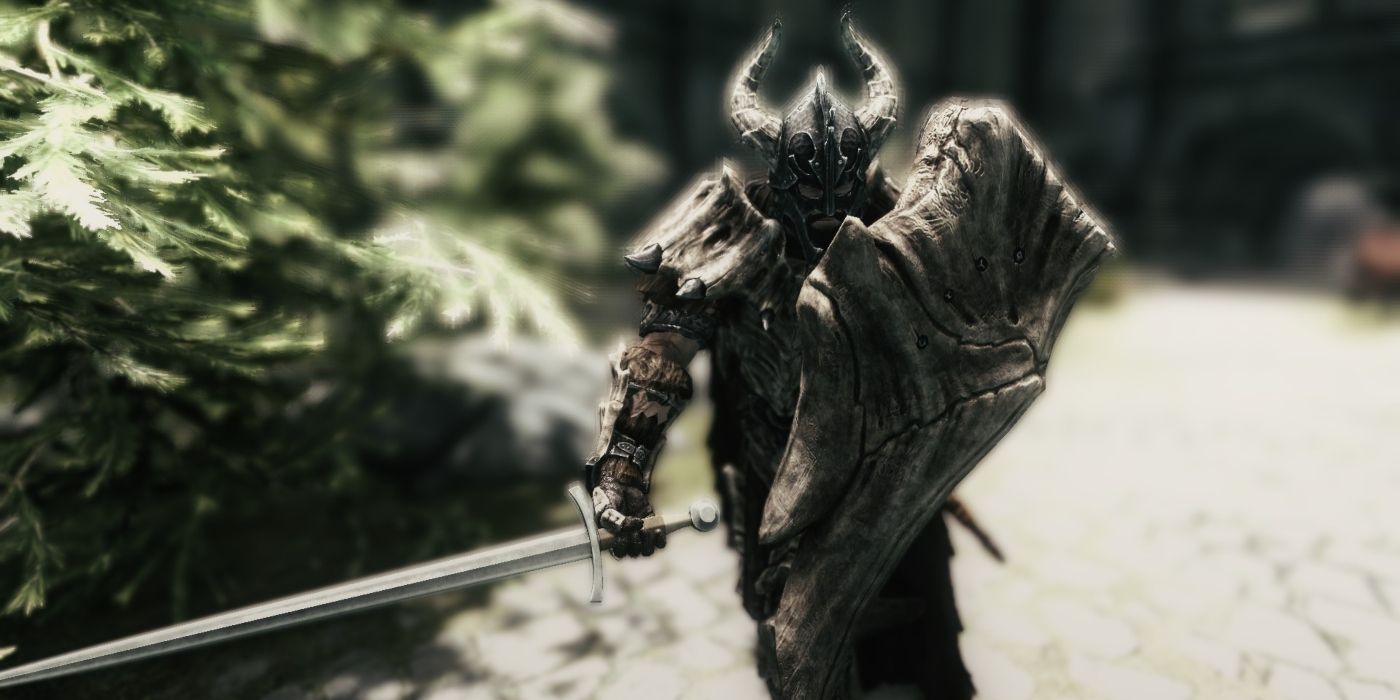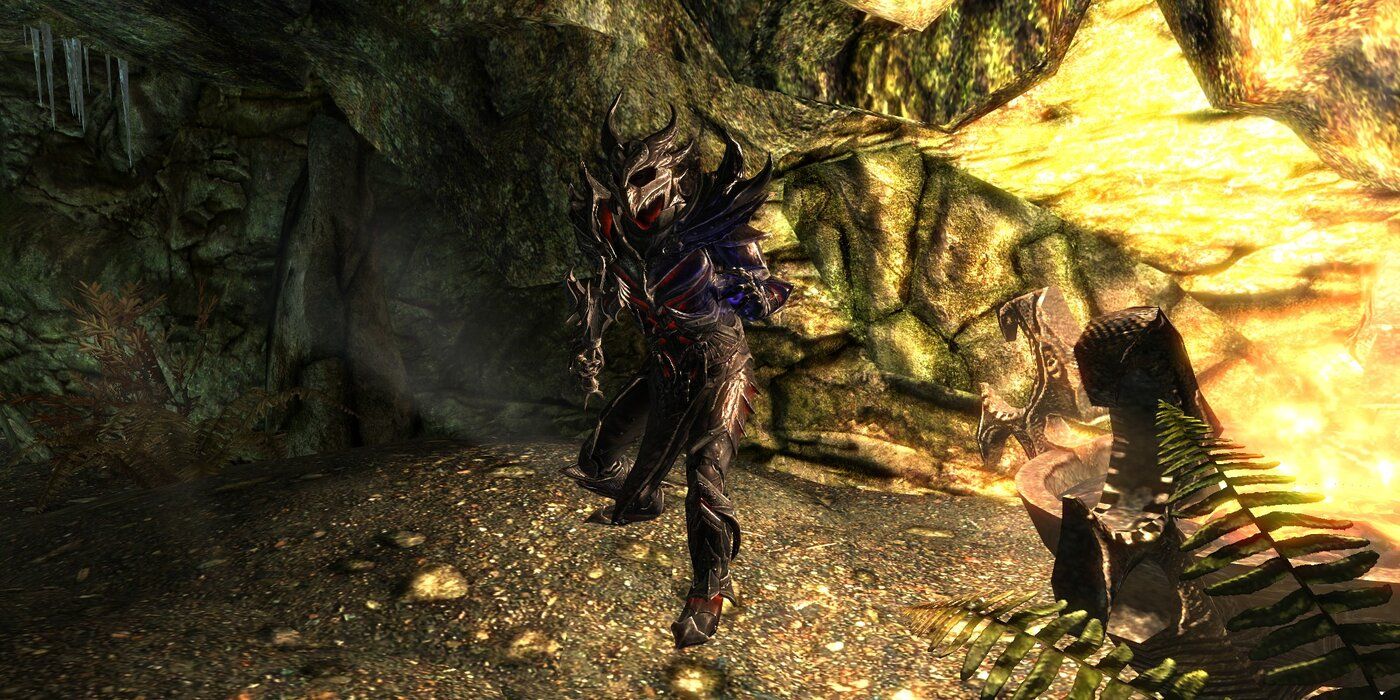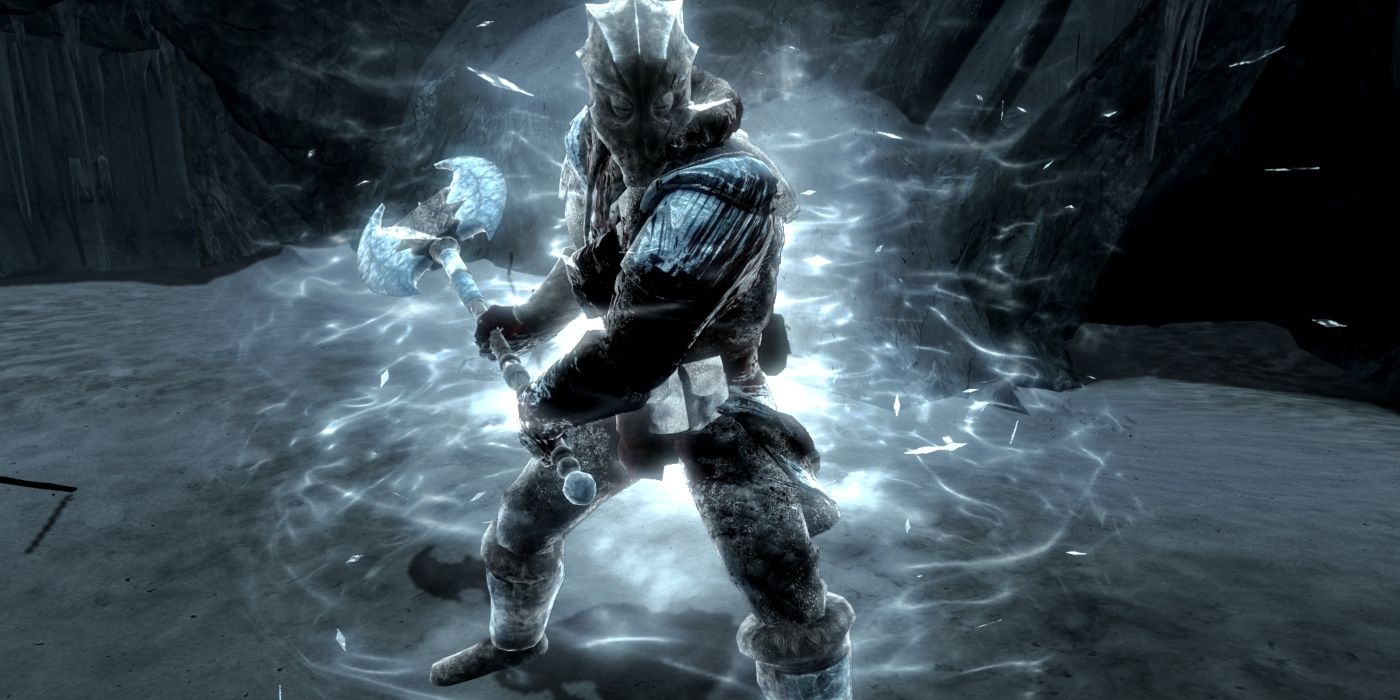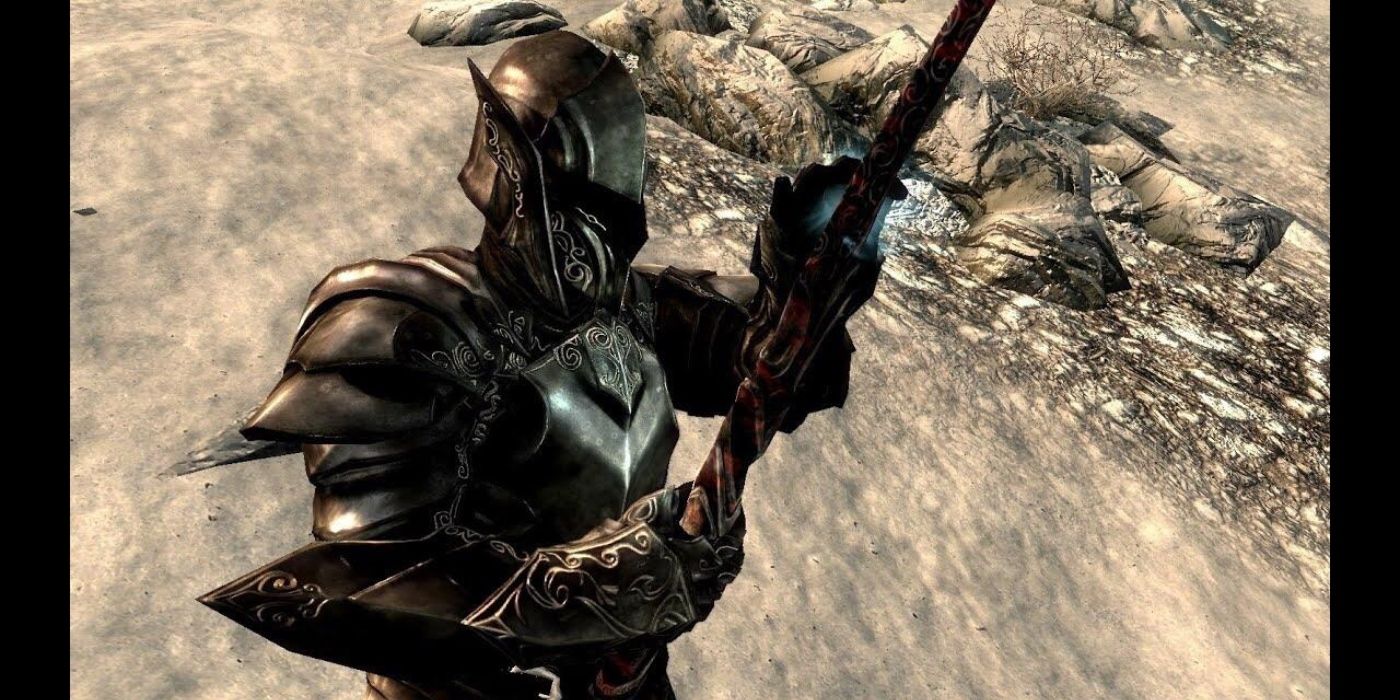Heavy Armor in The Elder Scrolls V: Skyrim has similar advantages to Light Armor, but there are some key differences that give it its own pros and cons. Skyrim is a harsh world, and oftentimes the best insurance policy is to put on the thickest plate mail and the most durable shield that gold can buy. Having a low armor rating in Skyrim is dangerous, and leaves players vulnerable to instant death blows from dragons and other high-level opponents. There’s nothing more depressing than seeing the Dragonborn get beheaded by a Forsworn Briarheart.
Light Armor favors mobility and stealth, but Heavy Armor is all about defense and tanking. In the mid-late game, and with enough perks, both armor types can reach the same threshold. The advantages of wearing Heavy Armor are most tangible in the early game. A prime example is when the player is up against Skyrim’s more dangerous animals, like the Cave Bear or Sabre Cat. At lower levels a Sabre Cat can kill an unarmored player in just a few quick hits - particularly if they get the drop on the player.
Survival is least assured early in the game, so that’s when the higher rating of heavy armor is crucial. Without taking any perks or crafting skills into account, a full set of (light) Leather Armor grants an armor rating of 58. By comparison, a full set of (heavy) Iron Armor has a rating of 65. Seven points might seem negligible, but when the player has a small health pool it can mean the difference in surviving an unexpected encounter. While an extra seven points of protection isn’t enough to stop Skyrim’s Giants from knocking players into the sky, Heavy Armor will prevent it earlier in the game than Light Armor can.
Leveling Skyrim’s Heavy Armor Skill Tree Has Pros And Cons
There are three choices given to the player in terms of defensive gear: Light Armor, Heavy Armor, or various robes or clothing. Unless the player is a mage, the main question comes down to Light Armor versus Heavy Armor. Categorically speaking, Light Armor falls under the game’s Rogue Skills. This is a good indicator of its intended uses. Players who tend towards thievery, archery, assassinations, and stealth should favor Light Armor, as its uses and perks better synergize with approaches of this ilk.
Heavy Armor, by comparison, is considered a Fighter Skill, and should therefore be considered alongside a more martial approach to the game. Rather than joining the Thieves Guild and working from the shadows, this archetype is better suited to joining the honorable Companions or fighting off vampires with the Dawnguard. For further proof of this bias, consider the weapons and armor that the guilds in question gift to the player upon joining: Once initiated, The Dark Brotherhood and Thieves Guild gives the Dragonborn unique sets of light armor. The Companions are all about Skyforge Steel, battleaxes, heavy armor, and other combat skills.
Besides the armor’s classification of heavy versus light, there are several other notable factors that play a part in determining an armor’s value. These include the armor’s material; any enhancements that were made to the armor via Smithing or Enchanting; any active perks in the respective armor skill trees; whether the player is using a shield; and the player’s Block skill. Even skill levels in Alchemy can enhance Skyrim’s defensive builds, since there are potions to fortify the player’s Smithing, Block, Enchanting, and the Light or Heavy Armor skills. Even just a few of these factors can combine to make a set of Light Armor more durable - and more desirable - than a set of Heavy Armor.
Take, for example, the aforementioned set of Iron Armor with the Armor Rating of 65. Elven Armor, which can be found early in the game, is Light Armor with an identical Armor Rating of 65. Iron Armor is easier to enhance at a forge, however, requiring cheaper materials and fewer perks. If the player has spent even one perk point in Light Armor’s Agile Defender, though, the Elven Armor will have a higher Armor Rating than the heavy set made of Iron. In this scenario, heavy armor’s superior durability is no longer true, and it loses out on its best advantage over light armor.
The Importance Of Skyrim’s Armor Perks
Some players in the early game make it a point to match combos of Skyrim’s armor, adorning pieces of both Light and Heavy. Since both skills in Skyrim are leveled through physical damage received, this is a quick way to power level both skill trees at once. Once the player has reached higher levels in either tree, though, it’s better to decide a preference and stick with it. This is because both skill trees have perks that offer significant bonuses to Armor Rating, but they only apply if the Dragonborn is wearing one armor type.
Well Fitted, for example, is a perk unlocked after reaching level 30 in Heavy Armor. This grants a 25% bonus to the player’s overall Armor Rating if they’re wearing Heavy Armor on their head, feet, chest, and hands. On the flip side, Light Armor’s Custom Fit is also offered at level 30 and is functionally identical. Both Skill Trees also have a Matching Set perk, which adds an additional stacked 25% to Armor Rating, but this time only if the player is wearing a set of the same armor type and material.
When going up against Skyrim’s toughest bosses, a higher Armor Rating means better odds of survival. The game does have an armor cap of 567, and this is important to note. While Daedric (700) and Dragonplate (668) can reach and exceed this number, the same can be said of fewer Light Armor variants. A full set of Dragonscale (581) can work, but a matching set of Glass Armor - even with maximum perks in Smithing and Light Armor - cannot exceed 559 without the aid of a shield, Alchemy, or Enchanting.
Use Skyrim’s Heavy Armor To Shrug Off Damage Dealt And Maximize Tanking
Which Perks To Choose
- Conditioning: The Conditioning perk is a good way of circumventing one of Heavy Armor’s more frustrating negative effects. Compared to Light Armor, Heavy Armor is weighty and slow. While sprinting speed isn’t an integral factor for a tough warrior, stamina management is critical. This perk not only makes traversal less of a nuisance; it also means power attacks are less costly.
- Well Fitted: Unlocked at level 30, this perk isn’t as much of a point sink as the Matching Set perk. Matching Set isn’t unlocked until level 70 and requires two additional perk points. Those points might be better spent on synergizing skills trees such as Smithing, Enchanting, or Block.
Which Perks Not To Choose
- Tower of Strength: Stagger isn’t an overly impactful consideration in The Elder Scrolls V, so perks to avoid it aren’t too helpful. By the time the player reaches the requisite level 50 needed to unlock this perk, they’re likely accustomed to shrugging off the rare stagger effect anyway. It’s better to invest perk points in ways to negate base damage than on ways to lessen the occasional side effect.
- Reflect Blows: Like Fists of Steel, this perk is fun, but ultimately useless. It’s entertaining to see enemies take damage from hitting the Dragonborn, but this damage is minimal. It’s also worth noting that this perk has no effect on the amount of damage received, and in no way protects the Dragonborn from damage.
Skyrim is available on PC, PlayStation 3, Xbox 360, PlayStation 4, Xbox One, PlayStation 5, Xbox Series X/S, and Nintendo Switch.
Header Source: BongDruid/moddb.com
Secondary Image Source: Tae-Rai/theskyforge.ning.com




